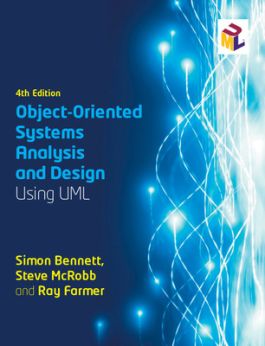Object-Oriented Systems Analysis and Design Using UML
4th Edition
0077125363
·
9780077125363
© 2010 | Published: April 16, 2010
The fourth edition of Object- Oriented Systems Analysis and Design has been revised and updated to reflect the most up-to-date approaches to information systems development. Still a best-seller in its field, Bennett’s, McRobb’s and Farmer’s tex…
Read More
Request Review Copy
Request More Info
Receive via shipping:
- Colour, print bound version of the complete text
A1 Agate Ltd Case Study—Introduction
B1 FoodCo Ltd Case Study—Introduction
1 Information Systems—What Are They?
2 Challenges in Information Systems Development
3 Meeting the Challenges
4 What is Object-Orientation?
5 Modelling Concepts
6 Requirements Capture
A2 Agate Ltd Case Study—Requirements Model
7 Requirement Analysis
A3 Agate Ltd Case Study—Requirements Analysis
8 Refining the Requirements Model
9 Object Interaction
10 Specifying Operations
11 Specifying Control
A4 Agate Ltd Case Study—Further Analysis
12 Moving into Design
13 Systems Design and Architecture
14 Detailed Design
15 Design Patterns
16 Human–Computer Interaction
17 Designing Boundary Classes
18 Data Management Design
A5 Agate Ltd Case Study—Design
19 Implementation
20 Software Reuse
21 Software Development Processes
The fourth edition of Object- Oriented Systems Analysis and Design has been revised and updated to reflect the most up-to-date approaches to information systems development. Still a best-seller in its field, Bennett’s, McRobb’s and Farmer’s text remains a key teaching resource for Systems Analysis and Design courses at both undergraduate and postgraduate level.
The book provides a clear, practical framework for development that uses all the major techniques from UML 2.2. It follows an iterative and incremental approach based on the industry-standard Unified Process, placing systems analysis and design in the context of the whole systems lifestyle. Structured in four parts, the first provides the background to information systems analysis and design and to object-orientation. The second part focuses on the activities of requirements gathering and systems analysis, as well as the basic notation of UML. Part three covers the activities of systems architecture and design, and UML notation for object design, and the book concludes with the implementation of systems and the issues of how the systems life cycle is organized and how reusable components can be developed.
The book provides a clear, practical framework for development that uses all the major techniques from UML 2.2. It follows an iterative and incremental approach based on the industry-standard Unified Process, placing systems analysis and design in the context of the whole systems lifestyle. Structured in four parts, the first provides the background to information systems analysis and design and to object-orientation. The second part focuses on the activities of requirements gathering and systems analysis, as well as the basic notation of UML. Part three covers the activities of systems architecture and design, and UML notation for object design, and the book concludes with the implementation of systems and the issues of how the systems life cycle is organized and how reusable components can be developed.
Updated notation following the very latest version of the UML standard.
Two realistic case studies that are used throughout the book - one for illustrative examples and the other for practical exercises for the reader.
Brand new, two colour text design.
Additional material on the Online Learning Centre website to complement the chapters in the book.
Supporting Websites
- Online Learning Center: http://highered.mheducation.com/sites/0077125363/information_center_view0/index.html

